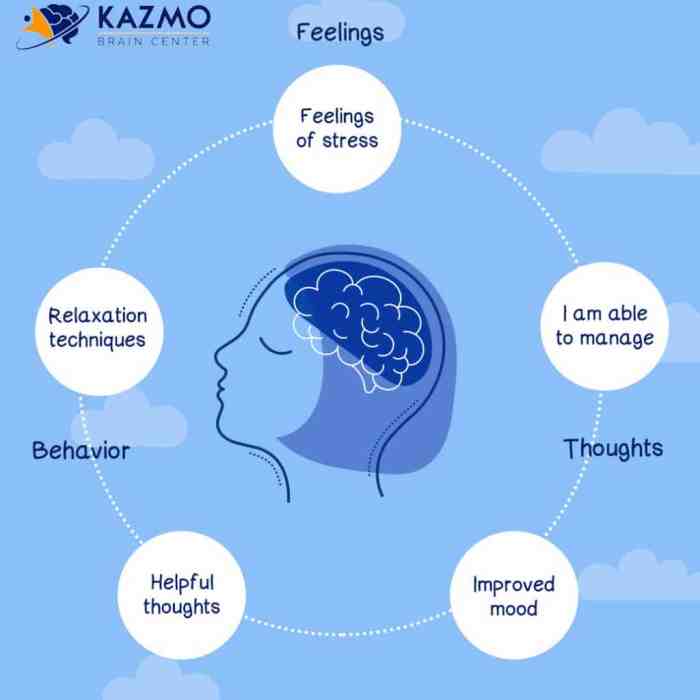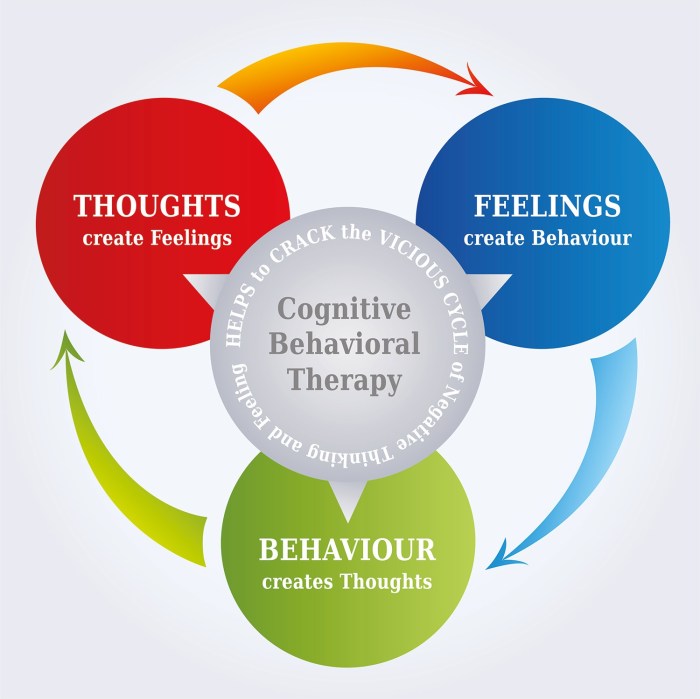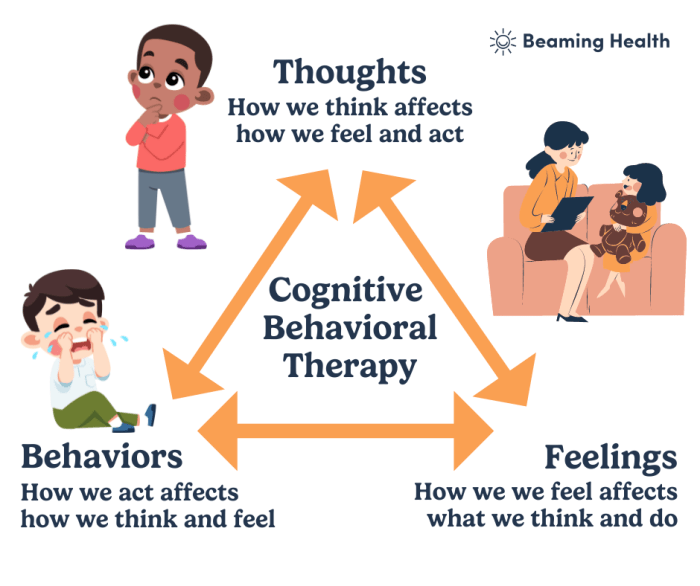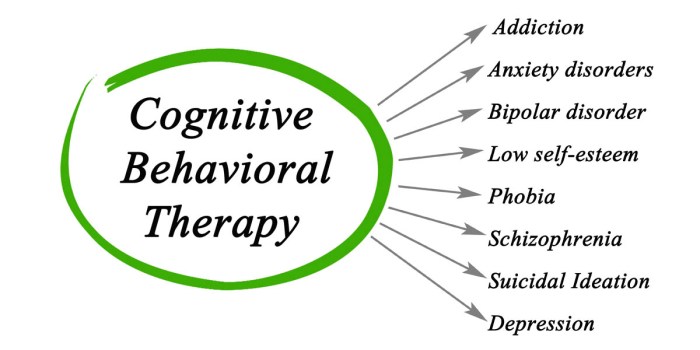Cognitive Behavioral Therapy: A Stress Management Tool

Cognitive behavioral therapy, or CBT for stress, is a powerful approach to managing stress that has gained widespread recognition for its effectiveness. This therapy focuses on identifying and changing negative thought patterns and behaviors that contribute to stress.
By understanding how our thoughts, feelings, and behaviors are interconnected, CBT empowers individuals to take control of their stress responses and cultivate greater resilience.
CBT’s roots lie in the principles of behavioral and cognitive psychology, recognizing that our thoughts and actions influence our emotions. Developed in the 1960s, CBT has evolved into a widely accepted therapeutic modality, backed by robust research demonstrating its efficacy in treating a range of mental health conditions, including stress.
Introduction to Cognitive Behavioral Therapy (CBT)

Cognitive Behavioral Therapy (CBT) is a widely used and effective form of psychotherapy that focuses on understanding the relationship between thoughts, feelings, and behaviors. It emphasizes that our thoughts influence our emotions and behaviors and that by changing our thinking patterns, we can change our emotional and behavioral responses.
CBT is particularly helpful in addressing stress, as it provides tools and strategies to manage negative thoughts and reactions to stressful situations.
Core Principles of CBT
CBT is based on the idea that our thoughts, feelings, and behaviors are interconnected and influence each other. It emphasizes the role of cognitive distortions, which are negative and often inaccurate thought patterns that contribute to stress and anxiety. CBT aims to identify these distortions and replace them with more balanced and realistic thoughts.
It also focuses on developing coping mechanisms and behavioral strategies to manage stress effectively.
History of CBT
The roots of CBT can be traced back to the work of Albert Ellis and Aaron Beck in the 1960s. Ellis developed Rational Emotive Behavior Therapy (REBT), which emphasized the importance of challenging irrational beliefs. Beck, on the other hand, developed Cognitive Therapy, which focused on identifying and correcting negative thought patterns.
These two approaches eventually merged to form CBT as we know it today.
Effectiveness of CBT for Stress
Numerous studies have demonstrated the effectiveness of CBT in treating stress. Research has shown that CBT can significantly reduce symptoms of stress, anxiety, and depression. It has also been found to be as effective as medication in some cases. Compared to other therapies, CBT offers a structured and practical approach that focuses on specific skills and techniques to manage stress.
Key Components of CBT for Stress
CBT for stress typically involves the following components:
- Identifying and challenging negative thoughts: CBT therapists help individuals identify and challenge their negative thoughts, replacing them with more balanced and realistic perspectives. This involves techniques such as cognitive restructuring and thought records.
- Developing coping mechanisms: CBT teaches individuals a range of coping mechanisms to manage stress effectively. These strategies include relaxation techniques, mindfulness practices, and problem-solving skills.
- Modifying behaviors: CBT focuses on changing behaviors that contribute to stress. This may involve setting realistic goals, prioritizing tasks, and managing time effectively.
- Improving communication skills: Effective communication is crucial for managing stress. CBT can help individuals develop better communication skills to express their needs and navigate challenging situations.
Examples of Cognitive Distortions
CBT identifies several common cognitive distortions that contribute to stress. Some examples include:
- All-or-nothing thinking: Viewing situations in extreme terms, such as “I either succeed or fail.”
- Overgeneralization: Drawing sweeping conclusions based on a single event, such as “I’m always late.”
- Mental filtering: Focusing only on the negative aspects of a situation, ignoring the positive ones.
- Disqualifying the positive: Dismissing positive experiences as not counting or not being significant.
- Jumping to conclusions: Making assumptions without sufficient evidence.
- Magnification and minimization: Exaggerating the importance of negative events and downplaying positive ones.
- Emotional reasoning: Believing that feelings reflect reality, such as “I feel anxious, so something must be wrong.”
- Should statements: Placing rigid demands on oneself or others, such as “I should be perfect.”
- Labeling: Attaching negative labels to oneself or others, such as “I’m a failure.”
- Personalization: Blaming oneself for events that are not under one’s control.
Cognitive Restructuring
Cognitive restructuring is a key technique used in CBT to challenge and change negative thoughts. It involves the following steps:
- Identify the negative thought: The first step is to become aware of the negative thought and its triggers.
- Challenge the thought: Once the thought is identified, it needs to be challenged. This involves asking questions such as:
- Is this thought true?
- Is there another way to look at this situation?
- What evidence supports this thought?
- What evidence contradicts this thought?
- Generate alternative thoughts: The next step is to generate alternative thoughts that are more balanced and realistic.
- Practice the new thoughts: The final step is to practice the new thoughts regularly until they become more automatic.
Example of Cognitive Restructuring
Let’s say you’re feeling stressed about an upcoming presentation. You might have thought: “I’m going to mess up this presentation and everyone will think I’m incompetent.”
- Identify the negative thought: “I’m going to mess up this presentation and everyone will think I’m incompetent.”
- Challenge the thought:
- Is this thought true? It’s possible to mess up a presentation, but it’s not guaranteed.
- Is there another way to look at this situation? Maybe I can focus on the positive aspects of my preparation and my ability to communicate effectively.
- What evidence supports this thought? I’ve prepared well and I have a good understanding of the topic.
- What evidence contradicts this thought? I’ve given presentations before and done well.
- Generate alternative thoughts: “I’ve prepared well and I’m confident in my ability to deliver a clear and informative presentation.”
- Practice the new thoughts: Regularly remind yourself of the alternative thoughts and practice them until they become more automatic.
Mindfulness
Mindfulness is a key component of CBT for stress. It involves paying attention to the present moment without judgment. Mindfulness practices, such as meditation and deep breathing exercises, can help individuals become more aware of their thoughts, feelings, and bodily sensations.
This increased awareness allows individuals to observe their stress responses without getting caught up in them.
Relaxation Techniques
Relaxation techniques are another important aspect of CBT for stress. These techniques help to reduce physical tension and promote a sense of calm. Some common relaxation techniques include:
- Progressive muscle relaxation: This technique involves systematically tensing and relaxing different muscle groups in the body.
- Deep breathing exercises: Deep, slow breaths can help to calm the nervous system and reduce stress.
- Guided imagery: This technique involves creating a mental image of a peaceful and relaxing scene.
Problem-Solving Skills
CBT helps individuals develop effective problem-solving skills to manage stress. This involves breaking down problems into smaller, more manageable steps and identifying potential solutions. By taking a structured approach to problem-solving, individuals can reduce feelings of overwhelm and increase their sense of control.
Time Management
Effective time management is essential for reducing stress. CBT can help individuals prioritize tasks, set realistic goals, and avoid procrastination. By managing their time effectively, individuals can reduce feelings of being overwhelmed and increase their sense of control over their lives.
Benefits of CBT for Stress
CBT offers numerous benefits for managing stress, including:
- Reduced stress and anxiety: CBT has been shown to significantly reduce symptoms of stress and anxiety.
- Improved mood and well-being: By changing negative thought patterns and developing coping mechanisms, CBT can improve overall mood and well-being.
- Increased self-awareness: CBT helps individuals become more aware of their thoughts, feelings, and behaviors, allowing them to identify triggers and develop strategies for managing stress.
- Enhanced coping skills: CBT provides individuals with a range of tools and techniques to manage stress effectively.
- Long-term benefits: CBT is a long-term solution for managing stress, as it equips individuals with skills that can be used throughout their lives.
How CBT Works for Stress

Cognitive Behavioral Therapy (CBT) is a structured and effective approach to managing stress. It helps individuals identify and change negative thought patterns and behaviors that contribute to their stress levels.
Cognitive Components of CBT for Stress
CBT recognizes that our thoughts play a significant role in how we feel and behave. Negative or distorted thoughts can amplify stress, while more positive and realistic thinking can help us cope better.
- Identifying Automatic Thoughts: CBT encourages individuals to become aware of their automatic thoughts, which are the quick, often negative thoughts that pop into their minds without conscious effort. These thoughts can be triggered by stressful situations or events. For example, a person might automatically think, “I’m going to fail this presentation,” when faced with a work presentation.
- Challenging Negative Thoughts: Once automatic thoughts are identified, CBT techniques help individuals challenge these thoughts by examining their validity and considering alternative perspectives. This involves asking questions like:
- Is this thought truly accurate?
- What evidence supports this thought?
- Are there other possible explanations for the situation?
- Cognitive Restructuring: This involves replacing negative thoughts with more balanced and realistic ones. For example, instead of thinking, “I’m going to fail this presentation,” a person might reframe their thought to, “I’ve prepared well, and I can do this.”
Behavioral Components of CBT for Stress
CBT focuses on modifying behaviors that contribute to stress. This involves identifying and changing unhealthy coping mechanisms and adopting more adaptive behaviors.
- Relaxation Techniques: CBT incorporates relaxation techniques like deep breathing, progressive muscle relaxation, and mindfulness meditation to help individuals manage physical and emotional stress responses. These techniques help calm the body and mind, reducing feelings of anxiety and tension.
- Stress Management Strategies: CBT teaches individuals practical stress management strategies, such as time management, assertiveness training, and problem-solving skills. These strategies help individuals better manage their daily demands and reduce the likelihood of feeling overwhelmed.
- Exposure Therapy: In some cases, CBT may involve exposure therapy, which gradually exposes individuals to situations that trigger their anxiety or stress. This helps them build tolerance and reduce their fear response over time. For example, a person with social anxiety might gradually expose themselves to social situations, starting with small steps and working their way up to more challenging ones.
Common Stressors and CBT Applications
Cognitive Behavioral Therapy (CBT) can be effectively applied to manage stress arising from various sources. It helps individuals identify and modify unhelpful thought patterns and behaviors that contribute to stress, promoting healthier coping mechanisms.
Tailoring CBT for Specific Stressors
CBT techniques can be tailored to address different types of stress. For example, if work-related stress is the primary concern, CBT can help individuals develop strategies for managing deadlines, prioritizing tasks, and setting boundaries. In cases of relationship stress, CBT can focus on improving communication skills, conflict resolution techniques, and fostering healthy boundaries.
Financial stress can be addressed through CBT by helping individuals develop budgeting skills, create financial plans, and reduce impulsive spending.
Common Stressors and Corresponding CBT Techniques
Here is a table outlining common stressors and corresponding CBT techniques:| Stressors | CBT Techniques ||—|—|| Work |
- Time management techniques
- Prioritization skills
- Setting boundaries
- Problem-solving strategies
- Stress-reduction techniques (e.g., deep breathing, mindfulness)
|| Relationships |
- Communication skills training
- Conflict resolution strategies
- Assertiveness training
- Active listening techniques
- Boundary setting
|| Finances |
- Budgeting skills development
- Financial planning
- Impulse control techniques
- Debt management strategies
- Financial literacy education
|
Examples of CBT Applications
Let’s consider a few examples of how CBT can be used to manage stress in different life situations:* Work stress: A person struggling with work-related stress might benefit from using CBT to identify and challenge negative thoughts about their workload. They can learn to break down large tasks into smaller, manageable steps and prioritize their responsibilities.
Relationship stress
In a relationship experiencing conflict, CBT can help partners improve their communication skills, practice active listening, and develop healthier ways to express their needs and feelings.
Financial stress
An individual overwhelmed by financial worries might use CBT to create a realistic budget, track their spending, and develop strategies for reducing debt. CBT can be a valuable tool for managing stress, providing individuals with the skills and strategies to navigate challenging situations and promote overall well-being.
Techniques Used in CBT for Stress

Cognitive Behavioral Therapy (CBT) for stress management employs a variety of techniques aimed at changing negative thought patterns and behaviors that contribute to stress. These techniques help individuals develop coping mechanisms and strategies to manage stress effectively.
Cognitive Restructuring
Cognitive restructuring is a core technique in CBT that focuses on identifying and challenging negative or distorted thoughts that contribute to stress. It involves examining the evidence for these thoughts and replacing them with more balanced and realistic perspectives.
- Identifying Automatic Thoughts: CBT therapists help individuals become aware of their automatic thoughts, which are the thoughts that pop up quickly and often without conscious effort. These thoughts can be negative, self-critical, or catastrophizing in nature.
- Evaluating the Evidence: Once automatic thoughts are identified, the next step is to evaluate the evidence for and against them. This involves asking questions like:
- What is the evidence that supports this thought?
- What is the evidence that contradicts this thought?
- Developing Alternative Thoughts: Based on the evidence gathered, individuals can develop more balanced and realistic alternative thoughts. These thoughts should be more helpful and less likely to contribute to stress.
- Reframing Situations: Cognitive restructuring also involves reframing situations in a more positive or neutral light. This can involve looking for the good in a situation, focusing on what is within one’s control, or finding a different perspective.
Relaxation Techniques
Relaxation techniques are essential components of CBT for stress management. These techniques help individuals reduce physiological arousal and promote a sense of calm.
- Deep Breathing Exercises: Deep breathing exercises involve taking slow, deep breaths that activate the parasympathetic nervous system, which is responsible for relaxation. This technique can help reduce heart rate, lower blood pressure, and promote a sense of calm.
- Progressive Muscle Relaxation: Progressive muscle relaxation involves tensing and releasing different muscle groups in the body. This technique helps individuals become aware of muscle tension and learn to relax specific muscles.
- Guided Imagery: Guided imagery involves using visualization to create a calming and relaxing mental experience. Individuals may imagine themselves in a peaceful and serene environment, such as a beach or a forest. This technique can help reduce stress and promote relaxation.
- Meditation: Meditation involves focusing attention on the present moment and accepting thoughts and feelings without judgment. This technique can help reduce stress, improve focus, and promote emotional regulation.
Mindfulness
Mindfulness is a practice that involves paying attention to the present moment without judgment. It helps individuals become more aware of their thoughts, feelings, and sensations without getting caught up in them.
- Mindful Breathing: Mindful breathing involves paying attention to the sensations of each breath as it enters and leaves the body. This technique helps individuals focus on the present moment and let go of distracting thoughts.
- Body Scan Meditation: Body scan meditation involves bringing awareness to different parts of the body, and noticing any sensations without judgment. This technique can help individuals become more aware of their physical state and reduce tension.
- Mindful Walking: Mindful walking involves paying attention to the sensations of walking, such as the feeling of the feet on the ground, the movement of the legs, and the rhythm of the breath. This technique can help individuals stay present and reduce stress.
Problem-Solving Skills
Problem-solving skills are essential for managing stress effectively. By learning to identify and address problems constructively, individuals can reduce feelings of overwhelm and helplessness.
- Defining the Problem: The first step in problem-solving is to clearly define the problem. This involves identifying the specific issue or situation that is causing stress.
- Generating Solutions: Once the problem is defined, the next step is to generate a list of possible solutions. This involves brainstorming and coming up with a variety of ideas, no matter how creative or unconventional they may seem.
- Evaluating Solutions: After generating a list of solutions, the next step is to evaluate them based on their feasibility, effectiveness, and potential consequences. This involves considering the pros and cons of each solution.
- Implementing a Solution: Once a solution has been chosen, the next step is to implement it. This involves taking action and putting the plan into practice.
- Evaluating the Outcome: After implementing a solution, it is important to evaluate the outcome. This involves assessing whether the solution was effective in addressing the problem and making any necessary adjustments.
Benefits of CBT for Stress
Cognitive Behavioral Therapy (CBT) is a powerful tool for managing stress, and its benefits extend beyond simply reducing immediate anxiety. It empowers individuals to develop long-term resilience and enhance their overall well-being.
Reduced Anxiety and Worry, Cognitive behavioral therapy for stress
CBT helps individuals identify and challenge negative thought patterns and behaviors that contribute to anxiety. By learning to recognize and reframe these thoughts, individuals can reduce their overall level of worry and anxiety. For instance, a person experiencing anticipatory anxiety about a presentation might use CBT techniques to break down the situation into smaller, manageable steps and focus on preparing effectively.
This approach can help shift their focus from the overwhelming feeling of anxiety to a more constructive, solution-oriented mindset.
Improved Sleep Quality
Stress often disrupts sleep patterns, leading to insomnia and other sleep-related issues. CBT addresses the underlying cognitive and behavioral factors that contribute to sleep difficulties. Techniques such as relaxation exercises, sleep hygiene practices, and cognitive restructuring can help individuals develop healthier sleep habits and improve their sleep quality.
For example, a person struggling with insomnia might be taught to create a calming bedtime routine, avoid screen time before bed, and practice relaxation techniques to ease their mind before sleep.
Increased Resilience
CBT fosters resilience by teaching individuals coping mechanisms for managing stress and adversity. Through CBT, individuals learn to identify their stress triggers, develop effective coping strategies, and build their capacity to bounce back from challenges. This increased resilience can positively impact various aspects of life, enabling individuals to navigate difficult situations with greater confidence and emotional stability.
For example, a person facing a demanding work deadline might use CBT techniques to break down the task into smaller, manageable steps, prioritize their workload effectively, and utilize relaxation exercises to manage stress levels.
Enhanced Coping Skills
CBT provides individuals with a range of practical coping skills to manage stress effectively. These skills include relaxation techniques, problem-solving strategies, assertiveness training, and communication skills. By mastering these skills, individuals can equip themselves with the tools necessary to navigate stressful situations confidently and maintain their emotional well-being.
For instance, a person experiencing social anxiety might learn to practice relaxation techniques before social events, develop assertive communication skills to express their needs and utilize problem-solving strategies to address potential social challenges.
Finding a CBT Therapist

Finding a qualified CBT therapist who specializes in stress management is crucial for your success in managing stress. A therapist with experience in stress-related issues can provide you with personalized guidance and support tailored to your specific needs.
Choosing a Therapist
When choosing a CBT therapist, it’s essential to consider their qualifications, experience, and approach. Here are some tips to help you find the right therapist:
- Look for a therapist who is licensed and certified in their state. This ensures they meet the minimum requirements for practicing therapy.
- Search for therapists who specialize in CBT and have experience treating stress-related disorders. You can find this information on their website or by contacting their office.
- Consider the therapist’s approach and personality. Some therapists may be more directive, while others may be more supportive. It’s important to find a therapist whose style aligns with your preferences.
- Read reviews and testimonials from previous clients to get an idea of the therapist’s effectiveness and communication style.
Establishing a Therapeutic Relationship
Building a strong therapeutic relationship is essential for successful therapy. Here are some tips for establishing a good relationship with your therapist:
- Be open and honest with your therapist about your experiences, thoughts, and feelings. This allows them to understand your situation better and provide tailored support.
- Communicate your needs and expectations. This ensures that you are both on the same page and working towards the same goals.
- Respect your therapist’s expertise and guidance. They are trained professionals who can provide you with valuable insights and strategies for managing stress.
- Be patient and persistent. It takes time to build trust and develop effective coping strategies. Be willing to put in the effort and stick with the therapy process.
Self-Help Resources for CBT
While professional guidance is recommended for severe or persistent stress, you can explore various self-help resources to learn more about CBT and practice its techniques independently. These resources can empower you to manage stress effectively and build resilience.
Books on CBT for Stress
Books provide a comprehensive understanding of CBT principles and practical exercises for stress management. Here are some recommended titles:
- “Feeling Good: The New Mood Therapy” by David D. Burns, MD: This classic guide explores the cognitive and behavioral techniques of CBT for various mental health issues, including stress, anxiety, and depression.
- “Mind Over Mood: Change How You Feel by Changing the Way You Think” by Dennis Greenberger and Christine A. Padesky: This book focuses on identifying and challenging negative thoughts and developing more adaptive coping strategies.
- “The Worry Cure: Seven Steps to Stop Worrying and Start Living” by Robert L. Leahy, PhD: This book provides specific techniques for managing worry and anxiety, based on CBT principles.
- “The Happiness Trap: How to Stop Struggling and Start Living” by Russ Harris: This book introduces Acceptance and Commitment Therapy (ACT), a form of CBT that emphasizes acceptance, mindfulness, and values-driven living.
Websites Offering CBT Techniques
Numerous websites offer valuable information, exercises, and resources for learning and practicing CBT.
- “The National Institute of Mental Health (NIMH): “This government website provides comprehensive information about mental health conditions, including stress, and offers resources for finding treatment and support.
- “The American Psychological Association (APA): “The APA offers articles, publications, and resources on various psychological topics, including CBT for stress management.
- “The National Alliance on Mental Illness (NAMI): “NAMI provides support and information for individuals with mental health conditions and their families, including resources on CBT and stress management.
Apps for CBT Practice
Mobile apps offer convenient and accessible tools for practicing CBT techniques and managing stress on the go.
- “Moodpath: “This app guides users through personalized CBT exercises for managing anxiety, stress, and low mood.
- “MindShift CBT: “Developed by the Anxiety and Depression Association of America (ADAA), this app offers CBT techniques for managing anxiety, including relaxation exercises and thought-challenging tools.
- “Happify: “This app uses gamified exercises and activities based on positive psychology and CBT principles to improve mood and well-being.
Summary: Cognitive Behavioral Therapy For Stress

CBT for stress offers a practical and evidence-based approach to navigating the challenges of daily life. By learning to identify and challenge unhelpful thoughts, develop healthier coping mechanisms, and build resilience, individuals can experience a profound transformation in their ability to manage stress and enhance their overall well-being.
Whether seeking professional guidance or exploring self-help resources, the principles of CBT can empower you to live a more fulfilling and stress-free life.
Comments are closed.